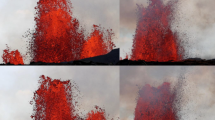Abstract
THE magma responsible for explosive volcanic eruptions has both a volatile and an inert phase. Deep in the conduit of an active volcano, bubbles nucleate as the volatiles exsolve1–3. As the magma rises, the bubbles grow through depressurization and continued exsolution. It is thought that when the pressure in the bubbles exceeds that in the overlying material, the magma undergoes a rapid transformation from a continuous magmatic phase with bubbles to a continuous gas phase with fragmented pyroclastic material1,2. The fragmentation process is complex and poorly understood. To understand better how the transport of fragmented material is coupled to exsolution and vaporization, we have performed depressurization experiments on a two-phase system, designed to simulate the eruption process. We identify a new explosive vaporization process, in which a fragmentation front propagates downwards through a mixture of volatile liquid and inert particulate material, suppressing the growth of nucleated bubbles by compressing the material ahead of it. This process is distinct from, and may complement, previously identified fragmentation mechanisms such as non-nucleate vaporization4 and fragmentation induced by an expanding magmatic foam5.
This is a preview of subscription content, access via your institution
Access options
Subscribe to this journal
Receive 51 print issues and online access
$199.00 per year
only $3.90 per issue
Buy this article
- Purchase on Springer Link
- Instant access to full article PDF
Prices may be subject to local taxes which are calculated during checkout
Similar content being viewed by others
References
Sparks, R. S. J. J. Volcan. geotherm. Res. 3, 1–37 (1978).
Wilson, L., Sparks, R. S. J. & Walker, G. P. L. Geophys. J. R. astr. Soc. 63, 117–148 (1980).
Hurwitz, S. & Navon, O. Earth planet. Sci. Lett. 122, 267–280 (1994).
Hill, L. G. & Sturtevant, B. in Adiabatic Waves in Liquid-Vapor Systems 25–37 (Springer, New York, 1990).
Mader, H. M. et al. Nature 372, 85–88 (1994).
Anderson, A. T. et al. Geology 17, 221–225 (1989).
Sheridan, M. F. & Wohletz, K. H. J. Volcan. geotherm. Res. 17, 1–29 (1983).
Gerlach, T. M. Eos 74, 104–105 (1993) (Abstr.).
Ortiz, L. A., Scott, R. & Lee, J. Int. J. Earthquake Engng Struct. Dynam. 11, 251–268 (1983).
Scott, R. Int. J. Soil Dyn. Earthquake Engng 2, 188–198 (1983).
Marble, F. E. Combustion and Propulsion: High Temperature Phenomena (eds Hagerty, R. P. et al.) 175–213 (5th Agardograph Colloq., Macmillan, New York, 1963).
Wohletz, K., McGetchin, T. R., Sandford, M. T. & Jones, E. M. J. Geophys. Res. 89, 8269–8286 (1984).
McBirney, A. R. & Murase, T. Bull. volcan. 34, 372–384 (1970).
Author information
Authors and Affiliations
Rights and permissions
About this article
Cite this article
Sugioka, I., Bursik, M. Explosive fragmentation of erupting magma. Nature 373, 689–692 (1995). https://doi.org/10.1038/373689a0
Received:
Accepted:
Issue Date:
DOI: https://doi.org/10.1038/373689a0
This article is cited by
-
An analog experiment of magma fragmentation: behavior of rapidly decompressed starch sirup
Shock Waves (2008)
-
Dynamics of explosive volcanism at Unzen volcano: an experimental contribution
Bulletin of Volcanology (2006)
-
Laboratory simulations of sustained volcanic eruptions
Nature (1997)
-
Magma fragmentation by rapid decompression
Nature (1996)
-
Exploding volcanic myths
Nature (1995)
Comments
By submitting a comment you agree to abide by our Terms and Community Guidelines. If you find something abusive or that does not comply with our terms or guidelines please flag it as inappropriate.



